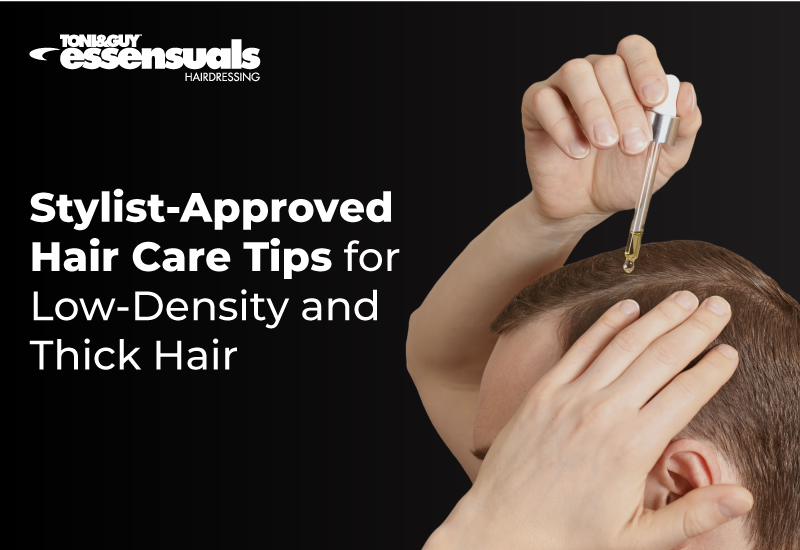Introduction: When Thickness Meets Flatness
Low Density and Thick Hair Care Tips – Hair that is thick per strand but low per density can be a styling paradox. You do have a body, but not necessarily volume. You do have texture, but your scalp can show through. Does that ring a bell? It all boils down to knowing what low-density and thick hair really is and embracing it with pro-style care. With the proper technique, you could gloriously rock fuller, easy-to-maintain hair that screams runway glamour, without any extortions from salons.
Understanding Low-Density And Thick Hair
- Low-Density Hair
Low-density hair is simply having a reduced number of follicles per square inch on your scalp! It has nothing to do with the thickness of the strand but with how many hairs grow in a given area.
- Thick Hair
Each individual hair strand is wide-diameter hair, which traditionally would feel fuller to the touch but does not lend much natural volume.
- Why This Combo Is Tricky
Thick hair and sparse hair snatch weight away from the natural lift, and sometimes your scalp is so obvious that even with plenty of texture, hair is strong by itself.
Best Cleansing Techniques For Your Hair Type
1. Shampoo Strategy: Sensitive, But Specific
Choose a sulfate-free shampoo that will gently cleanse while removing all buildup on the scalp.
- Pro Tip
Shampoo only the scalp and let it wash through the hair.
- How Often Should You Wash?
Usually, twice or thrice weekly is the best. Overwashing does risk losing natural volume and drying your thick strands.
2. Conditioning Properly: Focus On The Formula
Neither Lasting Too Little, Nor Too Much. Choose water-based conditioners or those that are intended for volume and hydration.
- What To Avoid
Heavy, silicone-heavy conditioners—these weigh down thick strands and flatten low-density areas.
- Application
Mid-lengths to ends only. Don’t apply conditioner to your scalp unless it is designed as a treatment for the scalp.
3. Drying And Detangling Bitterly
Make Microfiber Towels Your Best Friend. Give up regular towels for microfiber or a soft cotton t-shirt to avoid frizz and snapping.
- Detangle Gently
Use a Wide-Tooth Comb to take out the tangled hair. Remember to try to detangle the hair from the ends up!
- Add The Slip
Use a leave-in conditioner or detangling spray to help with slipping and snapping.
4. Heat Styling Do’s And Don’ts
Styling On Occasion. Heat styling ought to be in moderation, and you have
- Low-Density And Thick Hair Best Styling Tools
The Best Ionic Hairdryer is great at reducing frizz and cutting down the drying time.
- Flat Irons With Temperature Controls
Since control is paramount, use flat irons with ceramic or tourmaline plates that do not emit excess heat.
Volume Without Frizz: The Styling Game
The True Hair Styling Products for Volume are
1. Mousse
Good at the roots: Gives lift without any weight.
2. Light Foams Or Root Lifters
Great for sustained lift and texture.
3. Heavy Creams: Don’t Use Them
They cling to thick strands, dragging down the style.
Haircuts That Suit Thin And Thick Hair
1. Long Layers
They let the hair move without compromising its thickness.
2. Soft Waves
These types of hair are naturally voluminous and textured.
3. Half-Up
They hide thinner patches close to the scalp and flaunt the texture.
Steps For Growth-Friendly Hair
1. Scrub
Use a scalp scrub or one of those exfoliating shampoos once a week.
2. Blood Flow
Scalp massage is the ultimate when it comes to stimulating hair growth. Scalp massaging does provide nutrients to the follicles, which helps stimulate hair growth.
3. Nutrients For Thick Hair
- Feed Your Follicles: Maintain Protein Intake
Keratin is primarily a protein known for its abundance in the hair because hair consists mostly of keratin. Fingers crossed, therefore, that you remember to eat enough protein like lean meat, powdered soy, legumes, and eggs.
- Omega-Three Boosting
Foods should contain omega-3 fatty acids like flax seeds, walnuts, and fatty fish to help keep the scalp hydrated. A hydrated scalp, in turn, reduces swelling or other reactions.
- Hydration Point
Dry hair is frizzy hair. Hydration starts from within.
Salon Services That Can Help
1. Layered Cuts For Balance
Ask your stylist to texture the hair internally to remove bulk and enhance shape.
2. Root Tinting Or Low-Lights
These dimensions give the illusion of fullness to your hair colour.
3. Scalp Detox Treatments
Nice for cleansing away product buildup and balancing oil production.
Mistakes To Avoid: Common
1. Aggressively Brushing Wet Hair
Wet hair can also make it more elastic and vulnerable to breaking, especially when it has a thick density.
2. Overusing Dry Shampoo
While it raises your roots temporarily, overuse can create a buildup on your follicles, inhibiting growth and density.
3. Neglecting To Trim Your Hair
There are times you may not even see the split ends on your thick hair, but over time, you build up a lot of damage, which causes tangles and frizzy hair.
DIY Masks For Boosting Thickness And Shine
1. Avocado & Olive Oil Mask
It’s loaded with fats and vitamins to nourish coarse hair strands.
2. Aloe Vera & Castor Oil
This is a great mask for stimulating your scalp, while also strengthening your strands.
3. Egg & Yoghurt Protein Pack
Strengths: The shaft of each hair strand is great to use once a month.
Daily Hack For More Manageability When Styling
- Sleep With A Loose Braid
This has a dual purpose in preventing tangles and keeping the definition of your waves.
- Investing In Satin Or Silk Pillowcases
This literally reduces friction and helps to prevent hair from breaking.
- Don’t Forget The Pre-styling Serum
You want a good-weight serum that creates slip, adds shine, and also is a barrier before using heat or braids on your strands.
Why Essensuals Is The Best For Your Hair!
We find at Essensuals that low-density hair and thick hair do not fit.
Our trained stylists will make sure we tailor-make your haircut, your treatments, and ongoing care routines to help you manage and increase your thickness and volume. Whether you are going to wear your first precision layers with us or frizz-proof your hair, our goal is to elevate your experience. For those planning for a special occasion, check out Plan Your Bridal Hair for the Perfect Day for more inspiration.
Conclusion: Own The Texture, Master The Volume
Essenuals Low-density, thick hair may seem like an oxymoron, but with a little help, it can be your greatest strength. It is a balancing act with scalp health, purposeful styling, and products that work with your hair. Stop beating your head against the wall, lean into the volume, and with a little stylist-approved help, you’re just scratching the surface of your very best hair days.
FAQs On Low-Density And Thick Hair
1. Can low-density hair become denser over time?
You can’t change the number of follicles, but you can create the appearance of ‘bulk’ by improving scalp health and through volumising techniques.
2. Does thick hair frizz more easily?
Yes, and more so when dry or damaged. When your hair is properly moisturised and stylistically very little under heat, you should have less frizz with thick strands.
3. What hairstyle is most appropriate for thick, low-density hair?
Long layers or textured bob. With any cut, those styling features keep the balance, not allowing for flatness or weight/bulk.
4. Should I use oil on my hair?
Yes, but sparingly. Lighter oils (i.e., argan or jojoba) are excellent for shine and moisture – just don’t put any on the roots.
5. How can you tell if a product is too heavy for your hair?
Well, if your hair feels weighed down after using it, or if it gets greasy super fast, or maybe it just loses all its volume right away, those are pretty good signs that you should probably find something a little lighter.



0 Comments